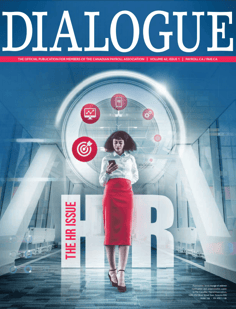
Turning data into decisions: the role of analytics in guiding strategy
Mar 01, 2020
Resources
Cindy Tarasow
HR & Analytics Specialist, PayworksCindy has over two decades of broad Human Resources experience across a number of private and public sectors, well-positioning her to serve Payworks’ clients as a subject matter expert in leveraging their organizations’ business intelligence to guide strategy and decision-making. Spécialiste, RH et analytique, Payworks
Comptant plus de 20 d’expérience dans le domaine des ressources humaines, autant dans le secteur privé que dans le secteur public, Cindy possède toutes les compétences nécessaires pour bien servir les clients de Payworks à titre de spécialiste des RH, les aidant à développer une intelligence d’affaires pour leur entreprise dans le but d’élaborer des stratégies et de prendre des décisions.

In the two years since we last explored workplace analytics (see “Analytics: An Indispensable Business Tool” in the March/April 2018 issue), payroll and HR professionals’ collective understanding of the capabilities of a workforce analytics solution has evolved almost as rapidly as the technology itself.
While this knowledge is fundamental to leveraging analytics effectively, it’s most useful when viewed through the lens of real-life application: how can this data and insight guide decision-making and lead to better (and more profitable) business outcomes?
Analytics in Action
For our clients in the food and hospitality industry, analytics has improved visibility into variable year-over-year payroll costs, presented through reader-friendly bar graphs and charts that highlight seasonal variance. One client was delighted to see her time spent reporting for 13 cost centres go from a seven-hour task down to 10 minutes—she could set filters, quickly confirm results visually, and then export the data already grouped and totaled, minimizing the data manipulation that would previously have been required.
The growing healthcare sector sees the benefits of analytics in terms of hours management, allocations and compliance. Federal reporting requirements for this sector can be burdensome, and our clients need to meet them accurately and on time. Analytics empowers users to easily compare payroll elements reflecting any time range, cost centre, department, configuration of people or type of hours (training, sick or vacation) to recognize patterns of use that inform better planning and patient support.
Many logistics, manufacturing and retail clients are using analytics to identify opportunities to improve the employee experience and HR processes. Changing demographics and talent shortages can make hiring and retention a significant challenge, but analytics can compare departments and occupations nationwide to reveal those with the highest turnover and provide timely insights into why in order to adapt workforce strategies accordingly.
Many clients report that having evidence of “problem areas” has led to better hiring decisions and improved on-boarding and training practices in those areas.
“What we were doing was great, but now we have the data to realign our efforts to the hottest spots with- out losing time to create those metrics,” one client shared. “Going forward, we can measure with far greater accuracy.”
These are just a few examples of workplace analytics. In addition to success stories like these, analytics can support HR Scorecards, providing more detailed and sophisticated measurements that can be managed. It can also identify opportunities for cost savings when it comes to benefits administration—for example, answering the question of whether or not there’s been a change in which benefits are being accessed over the years, and how that aligns to the needs of the staff demographics.
Each of these data-driven analyses take much of the guesswork and potential bias out of some of the most significant decisions payroll and HR professionals are called upon to inform. Analytics programs also complete in minutes what could take a person hours or even days to do manually.
Using this business intelligence to provide an informed response to the enterprise-wide question of “How should we invest our time and money most wisely to manage our talent?” makes an organization’s payroll and HR professionals indispensable.
Getting Buy-In
1. "We’ve been fine without analytics up until this point. Why would we need them now?”
It’s certainly possible for an organization to get by without the insight and data that analytics provides. However, this places a tremendous amount of pressure on an organization's leadership group to remain immersed in day-to-day details at a granular level so they can spot trends themselves. This can be particularly daunting during times of growth, when those details are changing on a daily basis, or for small businesses, where the leadership team wears many hats.
Encourage your leadership team to invest in their core deliverables and even greater business success by leveraging analytics as one of many tools in their management toolkit.
2. "We don't need analytics. We can just pull more reports."
Unless you already have all of your payroll and HR information contained in a single database, creating a report means manually exporting reports in multiple formats, and then individually comparing disparate databases to first align and then try to identify trends.
Analytics accesses exactly the right data sets within a single framework to answer your questions (the “what”), and it spots patterns that may not initially be visible through a traditional report (the “why”). This means faster, more accurate and higher- impact results.
3. "What are we supposed to do with this information once we’ve got it?”
Ultimately, the use of analytics allows an organization to evaluate, without bias, the effectiveness of paths it may have pursued in the past and feel confident in the decisions it makes for the future.
Analytics-driven strategy also encourages more experimental, creative thinking—when you have the ability to evaluate and course- correct in real time, you can allow more out-of-the-box thinking.
Both of these benefits set the stage for better decision-making and greater overall success.
There are some cautions when using analytics. It’s always important to keep privacy compliance in mind when gathering and sharing data. The Office of the Privacy Commissioner of Canada’s website (www.priv.gc.ca) is an excellent place to go for more information.
Also, use a critical eye when viewing the data, and ensure the filters and time frame are set correctly. Common-sense usage and application of analytics is the foundation of its success.
As with all technology-based solutions, we predict that analytics capabilities will continue to both broaden and deepen over the course of the next decade. One of the most immediate evolutions will likely be based upon the continued development of artificial intelligence (AI).
According to Payworks’ Chief Innovation Officer, Kevin Sokolowski, “Employee data is the scaffolding that AI will be built atop; the more data entered, the smarter the soft- ware will become.”
AI can assist analytics programs by further identifying trends, patterns and opportunities within data, allowing payroll and HR professionals to become even more proactive in interpreting those insights to guide business decisions, enhancing their position as strategic partners.
We encourage you to investigate how analytics can turn your business information into true business intelligence.

This article was written by Payworks HR and Analytics Specialist Cindy Tarasow. It was first featured in The Canadian Payroll Association's [payroll.ca] Dialogue Magazine.
These articles are produced by Payworks as an information service. They are not intended to substitute professional legal, regulatory, tax, or financial advice. Readers must rely on their own advisors, as applicable, for such advice.













